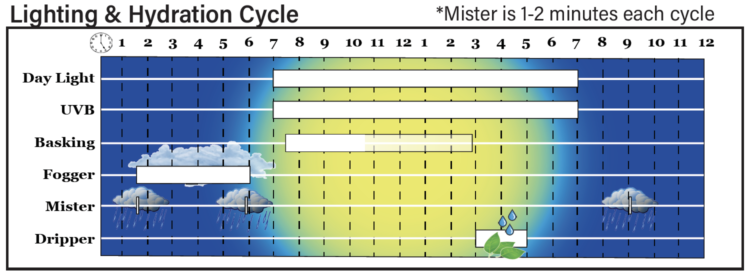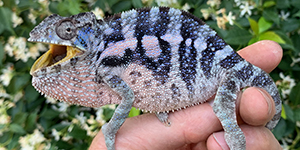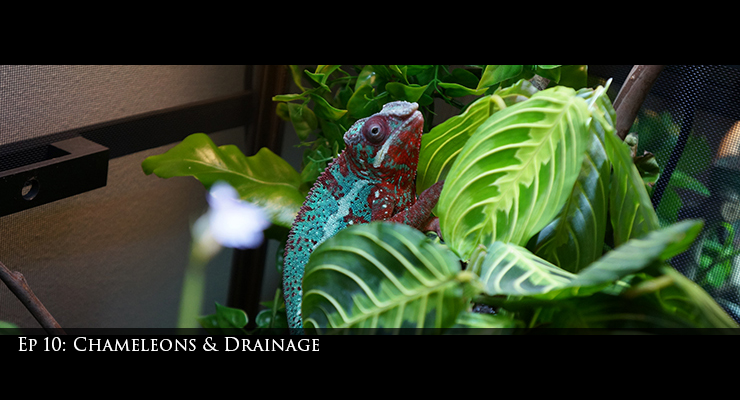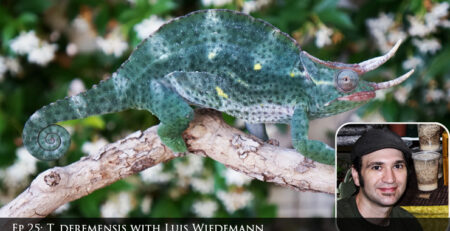Chameleon Environment: Length of Basking Time
The act of basking requires both the right amount of heat and the right amount of time. Although a warmer spot means less time needed to bask, going too hot produces burns. Most care sheets dictate that the basking bulb needs to be on all day. The logic is that the sun is up all day. But putting down a black and white schedule removes the keeper’s judgement from the situation. The purpose of a basking bulb is to warm the chameleon up in the morning. Once that job is completed, there may not be need for it again. And if it is left on it could actually be contributing to the overheating of the enclosure environment. But there will be situations where the ambient temperatures are low enough that a warm spot through out the day will be useful to the chameleon. On the Chameleon Academy care summary I have a gradient line indicating that keeper judgement should be used and the basking bulb length of time be intelligently applied with respect to the chameleon’s needs. I believe this to be a much more effective approach and produce a better husbandry.
Because of the problems with over-energizing veiled chameleons into producing life threatening amounts of eggs, there is also a school of thought that says to purposefully limit the basking time. Although this may be effective to reduce over-energizing the chameleons, I am not yet in a position where I am comfortable producing a “recipe” for doing this with the confidence that it will be carried out without a certain percentage of the keepers doing it wrong and producing an unhealthy environment. Thus basking length of time will also be an evolving parameter in chameleon husbandry.
The idea of purposefully limiting the basking independent of what the chameleon is communicating to you through their behavior is a practice that we need to thoughtfully consider. Whenever we decide that we know better than the chameleon what they need we must do it with great humility and care. There is no doubt that we do this all the time. Our chameleons are strangers to our enclosures and electronic energy sources. They have shown that our approach confuses them to the point where they will burn themselves trying to bask under a light that is too hot. So, limiting their access to dangerous levels of heat, UVB or food is a given. We have seen that they burn themselves, will expose their belly to excessively high UVB, and will eat to unhealthy levels (not that many of us are in the position to judge them).
But at what point do we over step our bounds and take too much control over a process which we have the barest of understanding? This is a question we must constantly keep in our minds as we create this environment for our chameleons. We are playing God with something that is not of our creation. This is a heavy responsibility that we must take seriously. We have a living being that is depending on us to make the right decisions.
I feel safe teaching newcomers to use moderate temperatures and to watch chameleon behavior to decide whether to limit basking time. I take the approach of watching your chameleon to determine if they have had enough. There may come a time where I feel that I will be effective enough in my communication that I could lead someone to limit basking time and be able to determine if the chameleon needs more. Is it better to err on the side of too long or too short? That is, in the end, the question we are asking. Each care sheet author and chameleon keeper must choose their path.
Conclusion
Length of basking time differs in caresheet direction between the common forcing of 12 hours of basking, the Chameleon Academy approach of adjusting length of time with respect to the communicated needs from the chameleon, and the purposefully limiting of basking time regardless of chameleon communication.
Recommending 12 hours on is a very basic approach. It is effective most of the time when using screen cages. The danger comes when it is presented as a requirement and keepers are told they must leave it on for 12 hours despite any mitigating environmental conditions. This is a simplistic mindset that comes from inexperience and you should rise above this as soon as you get orientated enough that you realize you are being taught from it.
Adjusting length of basking time with respect to chameleon behavior is a more sophisticated approach which does take more thought. I would encourage you to embrace it none the less. The art of chameleon keeping is not a simple recipe that will produce the same results every time in every “kitchen”. Your conditions are unique and the most effective way to create an effective chameleon environment is to be conscious and mindful of those conditions and how you must change them for your chameleon’s benefit.
Purposefully limiting the basking time is a level of control that you should take on once you are confident you understand the signs of under energized chameleons. It is possible this may be a normal practice in the future. If the keepers presently doing this show, over the years, more healthy, long lived chameleons that both grow to their full size potential as well as produce no infertile clutches then this practice will rightfully take its place as the standard.
I will be excited to change my recommendations to any method that brings the husbandry success of full sized chameleons with no infertile clutches across a wide range of keepers. Keep tuned in. This is a parameter that is being heavily tested out.
Back to the Chameleon Question Hub!
Click here to go back to the Chameleon Question Hub to review more questions!














